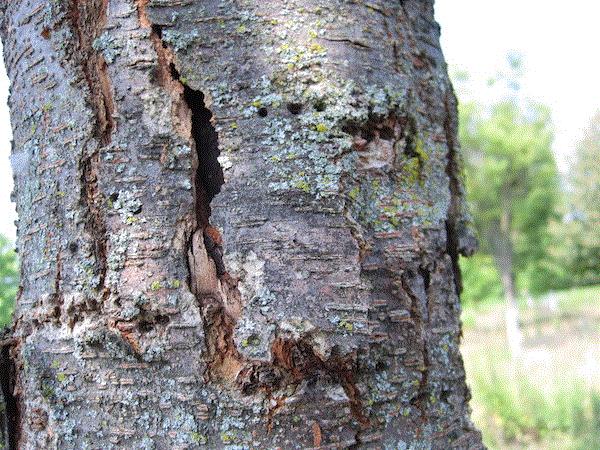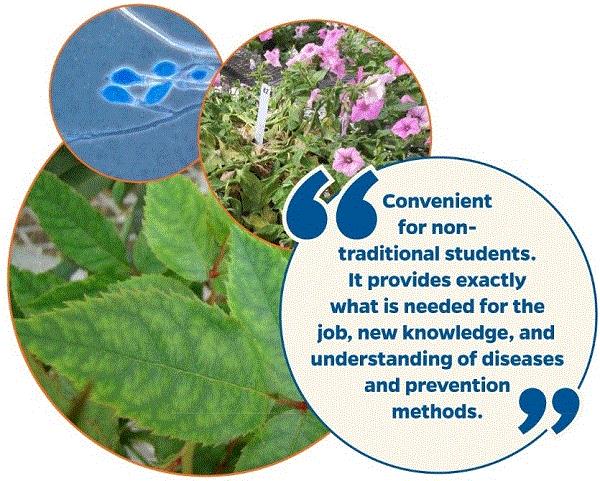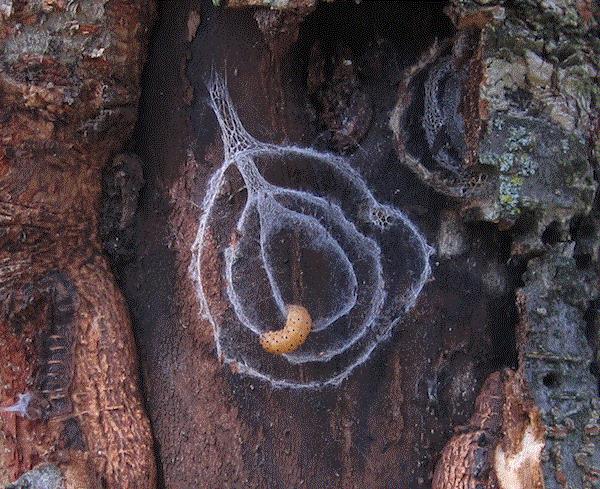What the ...?
Brian Walsh of Penn State Extension and I were communicating about some strange cankers on zelkova (Boo Hag and Lizard Man), among other things, when Brian shared a couple of pictures of one of the cankered zelkovas and what he found underneath.
I’m going to show you the canker now, but save what’s underneath to the end of the newsletter. It’s a good one—trust me.

Who's in there? (Photo credit: Brian Walsh, Penn State Extension.)
Box Tree Moth Webinars Are Available
Since USDA announced the detection of box tree moth in the United States in late May, all the major players in our industry leapt into action. American and Canadian plant health regulators at both the federal, provincial and state level intensified surveying and tracing efforts in all of the affected areas. Our industry representatives and extension services also provided educational opportunities.
The Horticultural Research Institute (HRI) organized a webinar on box tree moth on July 29, featuring updates from a multi-institutional team made up of collaborators from APHIS, IR-4, Cornell University, North Carolina State University and state departments of agriculture. Speakers discussed USDA’s and state regulators’ regulatory actions and survey results, efforts in developing a rearing method in USDA quarantine facility, trapping and lure development works in Europe, pest biology, and control. Click HERE to view a recording of the webinar.
Michigan State University and Clemson University also delivered a webinar on August 5. Speakers were Heidi Lindberg and Jeremy Jubenville of Michigan State, and me. We talked about the history of spread in Europe, surveying efforts in Michigan, pest identification and biology, and what it would mean to our industry if the pest becomes established. Click HERE to view a recording of this webinar.
One thing that came across during both webinars is that we don't have any real efficacy data because ...well ...no one in the United States has a population of this pest to work with. (In fact, I hope we won't have a permanent population to work with.)
Observations from Europe and Canada suggest that Bt works well and we also have very effective insecticides for caterpillar control. I suspect box tree moth isn’t that much more difficult to control than other caterpillar species.
In preparation for the webinar, I put a list together of insecticides registered for general caterpillar management. Email me for the list by clicking HERE or download a list compiled by Steve Frank of North Carolina State University, Dan Gilrein of Cornell University, and Cristi Palmer and Matthew Havers of the IR-4 Project by clicking HERE.
If you're interested in helping with the survey and trapping efforts, please contact your state plant industry regulators. If you want to find out in more detail how USDA and state departments of agriculture will be conducting their survey and management program, check out the new guidelines published by USDA by clicking HERE.

Fungus Gnats & Root Rot
In addition to solving (or attempting to solve) and providing education on mysterious pest problems, I spend much of my days writing—extension factsheets, magazine articles, newsletters, scientific papers, grant reports, trial reports, you name it. Right now, I’m working with Drew Jeffers of Clemson University’s Spartanburg County Cooperative Extension on an extension bulletin about fungus gnat management in propagation greenhouses.
You may think I can spew all sort of facts and tips about fungus gnats, but I can’t. There are still many facts about this pest that I need to learn about. There's no doubt that by feeding on plant roots, fungus gnat larvae have the potential to create wounds that root rot pathogens can take advantage of. But can fungus gnats really physically transmit root rot?
Multiple studies reported the detection of spores of Fusarium, Pythium, Thielaviopsis and Verticillium, and even viroid or viral genes on or in the digestive tracts of fungus gnat larvae. Adult fungus gnats can also carry on their bodies aerial spores of Botrytis, Fusarium, Thielaviopsis and Verticillium. Finding spores on or in the body means potential for transmission, but it doesn't mean disease development. You’ll still need to have a favorable environment and a susceptible host. (Remember the Disease Triangle?)
Considering how fungus gnats and root rots are favored by the same environment (wet medium), is a high incidence of disease in this kind of environment the result of greater transmission of pathogens by a greater number of fungus gnats or is it because of more pathogens? Many studies don't give a satisfactory answer.
El-Hamalawi and Stanghellini (2007; Plant Disease 89: 619-623) reported increased infection of lisianthus by Fusarium transmitted by fungus gnat adults. But Gillespie and Menzies (1993; Annals of Applied Biology 123: 539-544) reported that an increase in fungus gnat larvae didn't increase tomato plant infection by Fusarium. A study by Nam and colleagues (2017; Acta Horticulturae 1156: 857-861) found more fungus gnats, along with more diseases, in strawberries.
But does an increased abundance of fungus gnats really result in more transmission of pathogens and, therefore, greater severity of diseases? Sarah Braun and colleagues didn't think so. Based on their studies, it seems that, at least in the case of Pythium, fungus gnats are attracted to Pythium-infected plants, but they don't transmit Pythium. (See their article in GrowerTalks HERE.)
I would love to know what you think or see. Do you see greater incidence or severity of root rot diseases in a fungus gnat-infested greenhouse? Have I truly gone mad to challenge a dogma? Email me HERE.
Am I saying you shouldn’t worry about fungus gnats? No, my friend, you should worry. They can still damage your roots, and at times crowns and stems allowing the pathogens entry to the roots.
What’s the best way to prevent fungus gnats and root rot, you ask? Answer: Clean up your diseased plants and take the watering wand from that guy who loves his pots soaking wet. No favorable environment, no source, no problem. Boom! One of the world’s problems down. Now, to the next one ...

UF Greenhouse Online Training Continues
A new round of the University of Florida’s Greenhouse Training Online program started on May 31. Right now, participants are learning about cost and profitability. The online course will start sessions on disease management on September 13 and weed management on October 18. The sessions are available in both English and Spanish. You can sign up for only one or two sessions or the entire course.

Click HERE to register or find out more about the online training program.
Also check out the course’s YouTube channel. Lots of short, useful videos on various production and pest management topics, such as “Five tips on pesticides, water quality, and $$$.” Those dollar signs got my attention.
Answer to "What the ...?"
Brian found something really cool and something I haven't seen in person before: a dogbane saucrobotys was getting ready to pupate under a cankered bark of a zelkova tree.

Guess who's ready to become a beautiful ...moth? (Photo credit: Brian Walsh, Penn State Extension.)
The dogbane saucrobotys is a crambid, or snout moth, pretty widespread in the eastern United States and Canada (but can be found occasionally in other parts). I haven't seen them in person before, not because of COVID shutdowns, but because they're rather rare in my neck of the woods.
Caterpillars feed in a group on dogbane or Indian hemp (Apocynum species) and milkweed (Asclepias species). The caterpillar is often bright yellow with small black dots. Sometimes they can also be green, especially when they’re younger. A group of caterpillars can often make a nice web or tent that completely covers a terminal. The tent likely protects them from predators.
This nice specimen has found the canker to be a nice place to pupate. It spun silken tracks that were pretty interesting. To quote Brian, “It didn't spit out tickets like a real Skee-Ball machine.” Rats!




See y'all later!

JC Chong
Professor of Entomology at Clemson University
This e-mail received by 26,766 subscribers like you!
If you're interested in advertising on PestTalks contact Kim Brown ASAP!